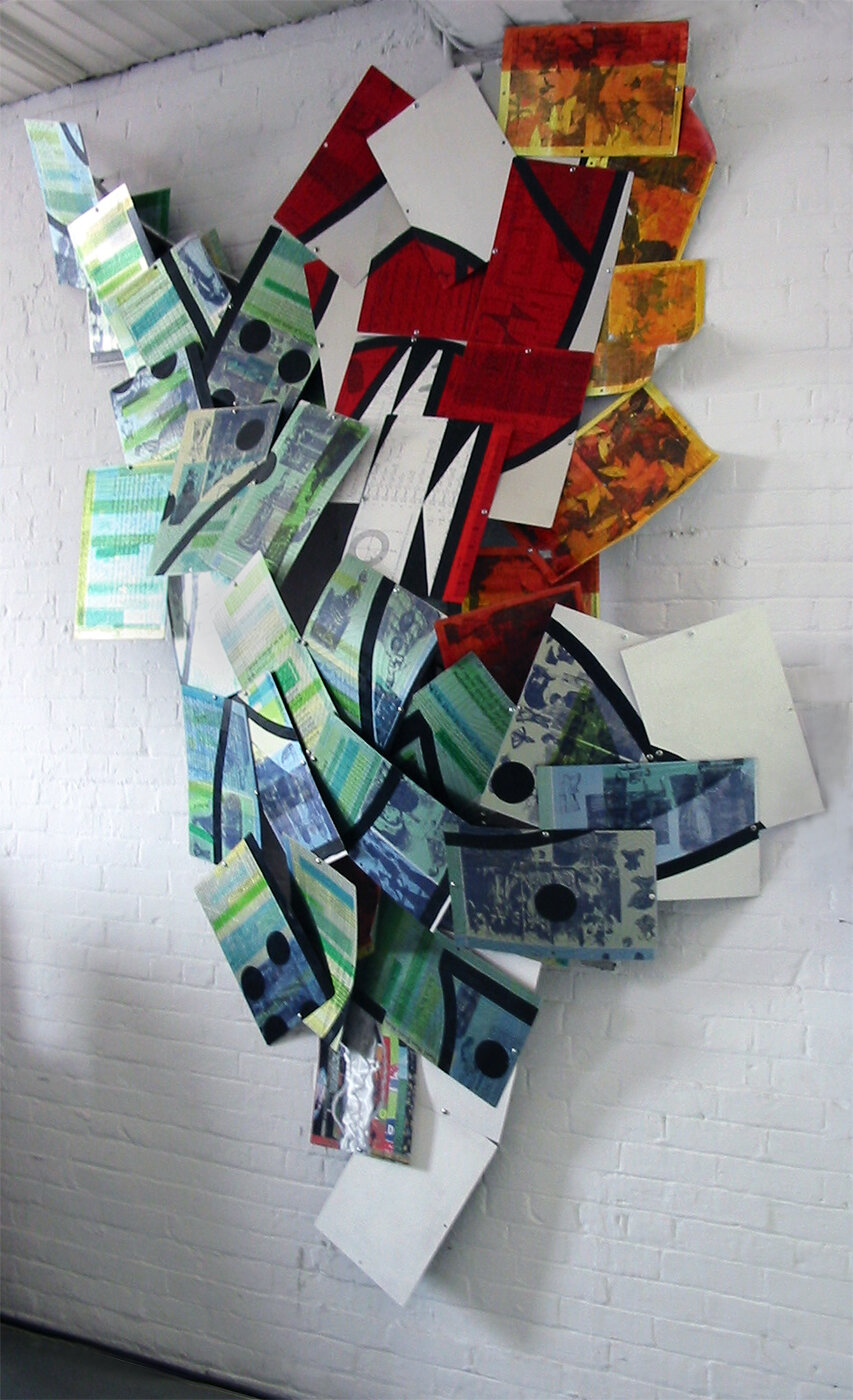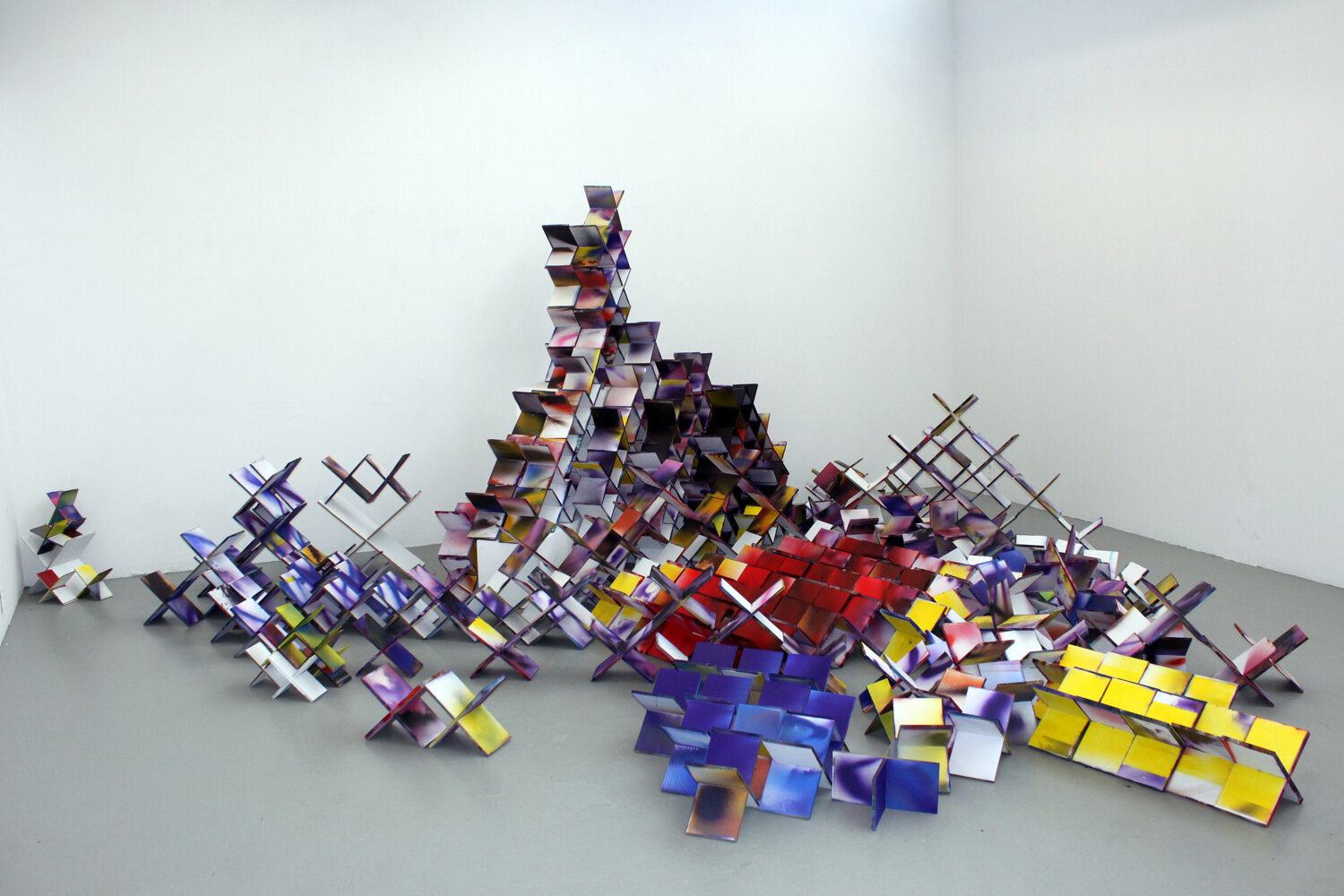Collage
Cut ‘n’ paste, CRISPR, mashups, hybrids, fusions, assemblage…
Collage, or a system of image and information synthesis, runs throughout my practice and across a variety of media. Artwork has been made by bringing together ideas and material from found and created base imagery including photographs, magazines, jpegs, cyanotypes, prints, maps, paintings, money, trash, gold, blueprints, bronze, cardboard and so on. The media has been acrylic, ink, oilstick, watercolor, weather, flora, ash, powder, snow, paper, cement, and digital imagery and more. It has been used in sculptures, installations, videos, sound works, music and poetry, and made with knives, saws, cameras, scanners, sewing machines, photocopiers, projectors, pencils, computer programs, 3D printers, stencils, brushes, samplers and synthesizers.
Some works have been quite small (6”), some are massive (10 storey high projection), some are constantly growing (new sections made in different global location being added to the artwork), and some are infinite in scale (the CRISPR installation in theory could arranged with its discrete units ever farther apart; In A Myriad could be chopped up into smaller pieces forever).
Some works last less then an hour (the weather works) and some are to continue over hundreds of years (additions or accretions occurring post-artist.)
The works are mashups of cultures, eras, times, experiences, locations, moods, colors, architectural spaces, tempos, voices, ideas and perspectives. They have been made in airplanes, studios, alleyways, computers, rooftops, subways, stairwells, galleries, desktops and iPhones, on lakes, sand dunes, mountainsides… (the below images are a survey of them).
The paper ones were first made and exhibited in Tokyo, LA, Toronto. The sliced linear style began in 1987. The concept came fully-formed in a daydream while sitting at trains station in Shinjuku: cut source images into linear segments, keeping only their core information for compression, and then interleave the strips thus enabling works using disparate material to cohere visually and conceptually. I described these works as having a visual rhyme scheme, A/B/A/B/C/C, with Image A appearing line 1, 3, 5 etc, Image B lines 2,4,6, etc. (I’ve also described them as DNA, each visual segment a building block joined to others to create a larger form.)
I used materials gathered from around Asia as I traveled, Japanese manga, Thai movie posters, Nepalese ads and so on along with materials from European and American magazines. The material was free (all I could afford) and easy to transport as a nomad. The works were first done ‘live’, on the street or subway, my version of graffiti, me and an Xacto and tape or pins, altering ads on the wall with linear slices cut, flipped, placed out of time, added (in today’s language, the images turned from analog to digital, disrupted, or even genetically modified within and across ads.
These sliced collages were small at first, done on paper, but eventually they became quite big — but I had to do them in sections, on panels, because that was the only way to make large images in a tiny Tokyo apartment. After completing the first large work I realized I could remix or disrupt the overall image by spinning or shifting one or all of the 4 constituent panels. Suddenly the work opened up with infinite possible version created from the same finite material, with those the image iterations impossible to predict. Even more interesting was that separately made paintings, with their own unique theme and image, could be combined with others to create new works. In effect each painting (collage) was part of a single larger painting. (This idea also led later to the recombinant installations and sculptures. By 1998 some works, on hundreds of aluminum panels intermixed together, reached 30 feet in length.)
The first exhibition of these early linear collages was in my apartment near Ikebukuro, 1987. The second was in a gallery in Ginza (1988), about 20 works in this style. The final showing in Japan was some of these works projected to about 70′ high, onto a building at Shibuya Station (above Hachiko) over a week, a project sponsored in part by the Canadian Embassy, the Shibuya Municipal gov’t, Tokyu Hands, and Heineken. (The other works below have shown in various places, guerilla to gallery, phone booth to museum, and been covered by the CBC, the Star, Japan Times, Lola, the Globe, Forbes, etc.)
I’ve continued to use this linear A/B/A/B approach over the years. It became much easier with Photoshop, though that also meant the style became ubiquitous, with ads, magazine and museum covers using it (Louis Vuitton, Adbusters, Montreal), and eveb becoming an App. The visual rhyme scheme approach later even showed up at the Venice Biennale in a video by Christian Marclay.
“Andersen moved from his earlier sharp edged forms comprised of sliced photographic printed matter into more blended and recognizable imagery. The collage fragments, although designed to comment on the work as a whole, appear here in a more textural capacity in conjunction with acrylic paint grids. Information in this case has become part of the fabric of daily life” - Japan Times
CONT’D below
My visual art compositional approach is heavily influenced by music: rhythm, rhyme, sampling, glitching, mashups, timestretching, echoes/delay, remixing...
Rashomon, the audio clip below is a collage song using the sliced image technique as applied to sonics. It uses microsamples of 30 previous Shinjuku Zulu and K.I.A. songs to create one resolving six minute piece. The song also places the listener in different architectural settings (small room to echoing cathedral). The track can be found on the “Sonorous Susurrus” album, which also includes “Large Slow River” which samples sound installation artist Janet Cardiff (somewhat using musique concrete techniques, her footsteps creating the polyrhythms.)
Various other songs — maybe all — I’ve made have used the collage approach, splicing genres, eras, vocals etc: “Dirty Liar” (hip hop, soul, banjo bluegrass), “Coal Coal Black” (1920s blues and dub), “Allelujah” (17th cent choral chants and dancehall), “Bedouin Engine” (acapella created from multiple global languages), “Music Is My DNA” (which has sections of different audio quality distortion), “Box the Gnat” (electronic squaredance, the rhythm created from soft-shoe dancing and sandpaper) and so on.
My recombinant works, especially the larger ones like CRISPR SCULPTR, are also open to interpretation — people other than the original artist (for ex. a curator, or owner) can be creatively involved in the work — coming up with their own unique arrangement. Some might critique this as a loss of authorship, but I see it more like how a musician might cover another writer’s song. (A personal example of this: I wrote a song called ‘Mrs Major Tom'“, and released it as an ambient electronic track. Later, Sheryl Crow covered it, but her version was acoustic.)
If curious, all the Shinjuku Zulu, as well as K.I.A. songs can be heard on Apple, Spotify, and all streaming services.



































